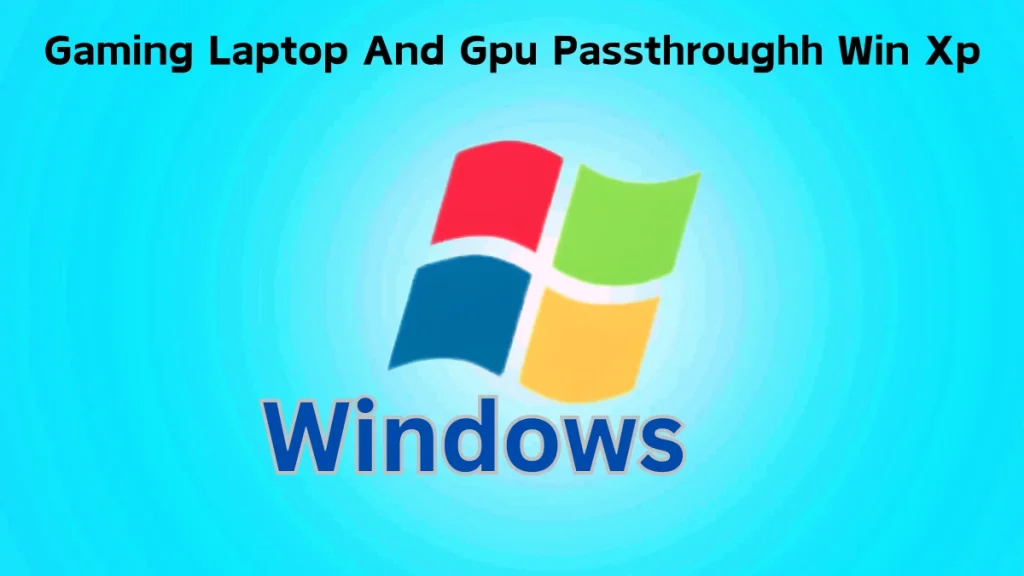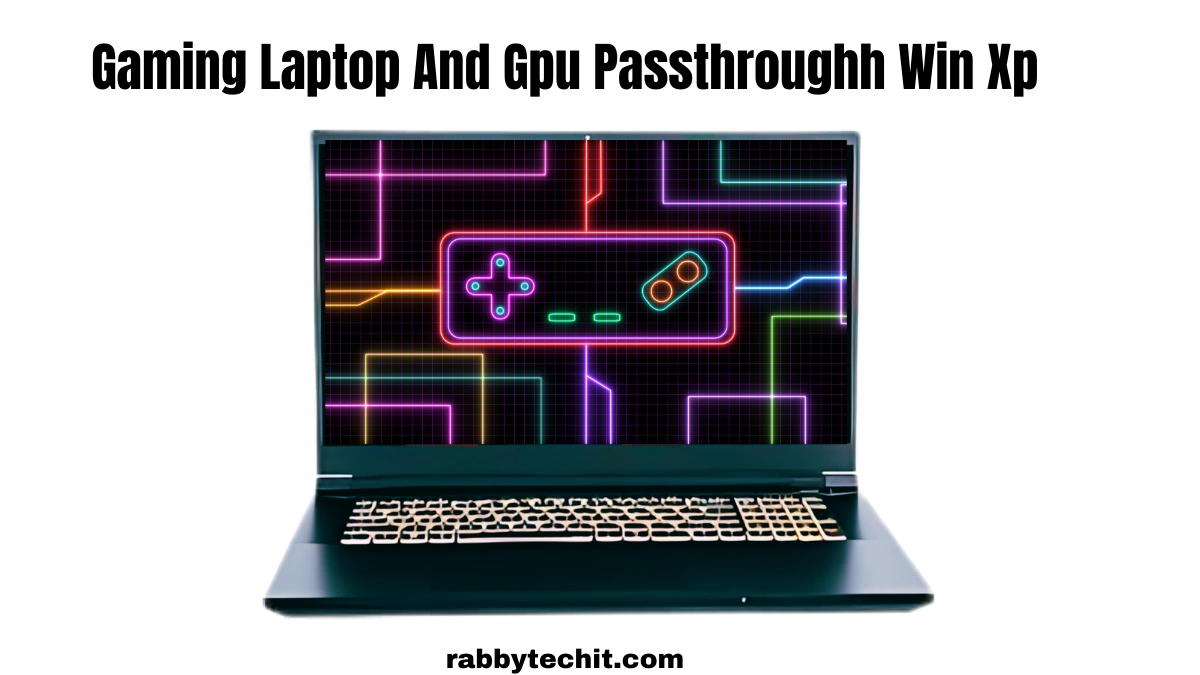Because of its nostalgic appeal, gamers frequently turn to older operating systems like Windows XP. They can now play these games again with contemporary gear. Using GPU passthrough to play Windows XP games on your gaming laptop is explained in this guide.
The fundamentals of GPU passthrough and its advantages for gaming will be discussed. You will discover how to configure a virtual machine. This will enable you to enjoy a fantastic retro gaming experience by making the most of your gear.
Examine GPU passthrough to discover how it might enhance the performance of your Gaming Laptop and GPU Passthrough Win XP. Compatibility, performance enhancement, and hardware virtualization will all be covered. This tutorial will get you ready to explore Windows XP gaming with a GPU.
Table of Contents
ToggleUnderstanding GPU Passthrough Technology and Its Benefits
For gaming, GPU passthrough is revolutionary. It enables users to directly allocate a graphics card to a virtual computer. This improves Windows XP gaming performance.
What Makes GPU Passthrough Essential for Gaming
A significant issue with virtual machines is resolved via GPU passthrough. It enables them to take advantage of a graphics card’s full potential. Better gaming without lag is what this entails.
Key Advantages for Windows XP Gaming Performance
- Unleashed Graphics Capabilities: GPU passthrough lets virtual machines use the graphics card’s full power. This means better gaming, even on older systems like Windows XP.
- Reduced Latency: It cuts down on input lag. This makes games feel more immersive and responsive
- Compatibility with Legacy Software: It lets users run old games and apps. This keeps their gaming library alive.
Hardware Virtualization Basics
GPU passthrough requires hardware virtualization. This divides a computer into multiple virtual machines. Each has its own operating system, resources, and programs.
GPU passthrough uses hardware virtualization to allow a dedicated graphics card to operate in a virtual environment. By doing this, you can gain improved game performance.
| Feature | Benefit |
| Direct Graphics Card Access | Improved gaming performance and the ability to run legacy software |
| Reduced Latency | Responsive and immersive gaming experience |
| Hardware Virtualization | Efficient partitioning of physical resources for virtual machines |
Hardware Requirements for Gaming Laptop and GPU Passthrough Win XP
You need the appropriate hardware in order to configure GPU passthrough on a Windows XP gaming laptop. For optimal performance, we’ll examine the essential components and attributes.
Processor Compatibility
The CPU in your laptop needs to support AMD-Vi or VT-d (IOMMU). These are essential for GPU passthrough, which enables direct graphics card use by the virtual machine. Select CPUs that have these virtualization capabilities.
Motherboard and BIOS Support
Additionally, the motherboard of your laptop must support VT-d. IOMMU and VT-d settings ought to be present in the BIOS. To utilize these functionalities, make sure your BIOS is configured correctly.
Graphics Card Compatibility
Your laptop’s graphics hardware has to support GPU passthrough. The majority of AMD and NVIDIA GPUs, including the Radeon and RTX series, are compatible. However, make sure your card model functions in a virtual environment.
PCIe Lanes and Bandwidth
Dedicated PCIe lanes for the graphics card are required for GPU passthrough. The GPU should have adequate lanes on your motherboard and chipset. For optimal gaming, consider the PCIe bandwidth as well.
| Hardware Requirement | Recommended Specification |
| CPU | Intel Core i5/i7/i9 or AMD Ryzen 5/7/9 with VT-d/IOMMU support |
| Motherboard | Supports IOMMU and VT-d in BIOS |
| Graphics Card | NVIDIA RTX or AMD Radeon series with dedicated PCIe lanes |
| PCIe Lanes | Minimum of 16 PCIe 3.0 or higher lanes for the dedicated GPU |
You can have a fantastic GPU passthrough configuration by fulfilling these hardware requirements. This will enable you to play contemporary games and run Windows XP.

A high-performance gaming laptop disassembled, showcasing its internal components such as a powerful CPU, high-capacity RAM modules, a cutting-edge GPU, cooling fans, and intricate circuit boards, all placed on a sleek, modern workspace with ambient lighting.
Preparing Your Gaming Laptop for Virtual Machine Setup
For seamless Windows XP gaming, prepare your gaming laptop for a virtual machine. You must install drivers, configure your BIOS, and verify that your system is operating properly.
BIOS Configuration Steps
First, go into the BIOS of your laptop and activate the virtualization technology. Verify that AMD-V or Intel VT-x are configured correctly. Additionally, look for PCIe ACS options and IOMMU groups for GPU passthrough.
Essential Driver Installation
Next, install the graphics card and other hardware drivers. Ensure that you download the most recent drivers from the manufacturer’s website. This guarantees optimal performance and smooth operation of your equipment.
System Compatibility Checks
- Make sure your laptop’s kernel parameters support virtualization and GPU passthrough.
- Look for any issues or limits with your hardware and Windows XP.
- Check if your laptop’s CPU, RAM, and storage can handle the virtual machine and gaming.
You may build up a fantastic virtual machine by carefully prepping your laptop’s BIOS, installing drivers, and verifying system compatibility. This will enable GPU passthrough for a seamless Windows XP gaming experience.
A close-up view of a gaming laptop’s BIOS settings interface, featuring a sleek dark theme with glowing accents, highlighted sections showing options for virtualization and GPU settings, intricate patterns on the motherboard in the background, soft ambient lighting creating a techy atmosphere.
Virtual Machine Configuration and Windows XP Installation
The secret to a fantastic Windows XP gaming experience is setting up a virtual machine. Installing Windows XP, configuring the virtual hardware, and selecting the appropriate hypervisor are all necessary.
You can select VirtualBox or QEMU/KVM as your hypervisor. Both allow GPU passthrough and are excellent for virtualization. This enables you to run your virtual machine on a dedicated graphics card.
- First, download the right Windows XP ISO file. Make sure it fits your version and architecture.
- Then, set up your virtual machine’s virtual hardware allocation. This includes the processor, memory, and storage, all tailored for gaming.
- Next, configure your hypervisor setup. You’ll need to enable virtualization extensions and IOMMU support for GPU passthrough.
- Finally, install Windows XP in your virtual machine. Make sure you have the right drivers and updates.
| Hypervisor | Key Features | Supported Operating Systems |
| QEMU/KVM | Open-source, powerful virtualization solution with GPU passthrough support | Linux, Windows, macOS |
| VirtualBox | Free, cross-platform virtualization tool with GPU passthrough capabilities | Windows, Linux, macOS |
You may now enjoy your gaming laptop and GPU passthrough technology after installing Windows XP and configuring your virtual machine properly.
Setting Up GPU Passthrough in Your Virtual Environment
Investigating GPU passthrough will help you realize the full potential of your gaming laptop. You can use a dedicated graphics card in your virtual machine thanks to this technology. This comprehensive procedure improves your Windows XP gaming experience.
IOMMU Group Configuration
You can get the most out of your gaming laptop by looking into GPU passthrough. This technique allows you to employ a dedicated graphics card in your virtual computer. This thorough process enhances your gaming experience on Windows XP.

PCI Device Assignment
Assign PCI devices to your virtual machine once IOMMU groups have been configured. This covers the graphics card as well as additional hardware such as network connections or audio. To ensure a seamless gaming experience, make sure all required devices are connected.
Graphics Card Integration Steps
Integrating the graphics card into your virtual system is the final step. You must install the appropriate drivers and setup your hypervisor software. This maximizes the performance of your virtual computer for gaming.
| Step | Description |
| 1. IOMMU Group Configuration | Ensure your system’s IOMMU groups are properly configured to isolate PCI devices for VFIO compatibility. |
| 2. PCI Device Assignment | Assign the necessary PCI devices, including the graphics card and supporting peripherals, to your virtual machine. |
| 3. Graphics Card Integration | Carefully configure the hypervisor, install the correct drivers, and optimize the virtual machine’s settings for optimal gaming performance. |
Optimizing Windows XP Performance for Modern Gaming
Optimizing the performance of your Windows XP virtual machine is necessary while setting it up for gaming. Verify that your display drivers are up to date and compatible with the most recent DirectX versions. This procedure can significantly increase system speed and graphics.
To strike a balance between frame rates and visual quality, investigate resolution scaling. High resolutions may not be effectively handled by older games. For a more fluid gaming experience, try reducing the resolution. Additionally, watch for community-provided game updates or fixes that can enhance performance.
Remember to adjust for performance. Optimize game visual settings, change power settings, and turn off unnecessary background services. Even on outdated hardware in a virtual machine, these few adjustments can greatly improve your gaming experience.
FAQ
What is GPU passthrough technology?
Allowing a virtual machine (VM) to use a dedicated graphics card is known as GPU passthrough. Performance is improved, particularly during gaming.
Why is GPU passthrough essential for Windows XP gaming on modern laptops?
It is essential for current laptops to run Windows XP games. It enables direct usage of the dedicated GPU by the virtual machine. Compared to software emulation, this offers superior compatibility and performance.
What are the key advantages of using GPU passthrough for Windows XP gaming?
Better graphics, faster frame rates, and compatibility with older graphics APIs are the primary advantages. For a fantastic gaming experience, it also enables you to utilize the GPU to its maximum potential.
What hardware requirements are needed for successful GPU passthrough on a gaming laptop?
A motherboard with an IOMMU-enabled BIOS, a dedicated graphics card, and a CPU with IOMMU support are required. It is necessary to separate the host system from the GPU. For the setup, you also need adequate PCIe lanes.
How do I prepare my gaming laptop for the virtual machine setup and GPU passthrough?
First, configure the BIOS to support IOMMU and virtualization. After that, verify system compatibility and install drivers. This guarantees a seamless GPU passthrough configuration.
What are the steps involved in setting up the virtual machine and configuring GPU passthrough?
First, choose a virtualization program such as VirtualBox or QEMU/KVM. Set up a virtual machine and install Windows XP. Next, set up graphics card integration, PCI device assignment, and IOMMU groups.
How can I optimize the performance of Windows XP games in the virtual environment?
Concentrate on driver optimization and resolving DirectX problems to enhance gaming. Apply game patches and adjust the resolution. Adjust the VM’s performance as well.



